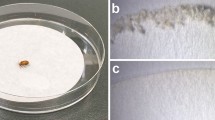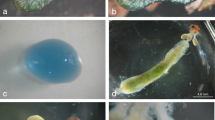Abstract
Larvae of the diamondback moth, Plutella xylostella, a crucifer specialist, refuse to feed on a crucifer, Barbarea vulgaris, because of the presence of a feeding deterrent, which is extractable with chloroform. We isolated a feeding deterrent from B. vulgaris leaves, by successive fractionations with silica-gel, ODS, i.e., C18 reversed phase, and Sephadex LH-20 column chromatographies, and ODS-HPLC, guided by a bioassay for feeding deterrent activity. The structure of the compound was determined to be a monodesmosidic triterpenoid saponin, 3-O-[O-β-D-glucopyranosyl-(1→4)-β-D-glucopyranosyl]-hederagenin, based on FAB-MS, 1H- and 13C-NMR spectra, and hydrolysis experiments. When the compound was applied to cabbage leaf disks at greater than 0.18 μg/mm2, consumption of the disks by third instars was less than 11% of control disks treated with the solvent alone. Furthermore, all first instars died on the disks treated with the same concentrations. Because the concentration of the compound in the fresh leaves of B. vulgaris was comparable to the effective dose in the cabbage leaf disk tested, we conclude that the unacceptability of B. vulgaris to P. xylostella larvae is primarily due to this saponin.
Similar content being viewed by others
REFERENCES
Aoki, T., Tanio, Y., and Suga, T. 1976. Triterpenoid saponins from Fatsia japonica. Phytochemistry 15:781–784.
Daido, M., Fukamiya, N., Okano, M., Tagahara, K., Hatakoshi, M., and Yamazaki, H. 1993. Antifeedant and insecticidal activity of quassinoides against diamondback moth (Plutella xylostella). Biosci. Biotech. Biochem. 57:244–246.
Fahleson, A., Eriksson, I., and Glimelius, K. 1994. Intertribal somatic hybrids between Brassica napus and Barbarea vulgaris-production of in vitro plantlets. Plants Cell Rep. 13:411–416.
Feeny, P. 1977. Defensive ecology of the Cruciferae. Ann. Mo. Bot. Gard. 64:221–234.
Gupta, P. D. and Thorsteinson, A. J. 1960a. Food plant relationship of diamondback moth (Plutella maculipennis (Curt.)). I. Gustation and olfaction in relation to botanical specificity of larva. Entomol. Exp. Appl. 3:241–250.
Gupta, P. D. and Thorsteinson, A. J. 1960b. Food plant relationship of diamondback moth (Plutella maculipennis (Curt.)). II. Sensory relationship of oviposition of the adult female. Entomol. Exp.Appl. 3:305–314.
Hermawan, W., Nakajima, S., Tsukuda, R., Fujisaki, K., and Nakasuji, F. 1997. Isolation of an antifeedant compound from Andrographis paniculata (Acanthaceae) against the diamondback moth, Plutella xylostella (Lepidoptera: Yponomeutidae). Appl. Entomol. Zool. 32:551–559.
Hillyer, R. J. and Thorsteinson, A. J. 1969. The influence of the host plants or males on ovarian development or oviposition in diamondback moth, Plutella maculipennis (Curt.). Can. J. Zool. 47:805–816.
Hostettmann, K. and Marston, A. 1995. Saponins. Cambridge University Press, Cambridge, p. 548.
Huang, X., Renwick, J. A. A., and Sachdev-Gupta, K. 1994. Oviposition stimulants in Barbarea vulgaris for Pieris rapae and P. napi oleracea: Isolation, identification and differential activity. J. Chem. Ecol. 20:423–438.
Idris, A. B. and Grafius, E. 1996. Effects of wild and cultivated host plants on oviposition, survival, and development of diamondback moth (Lepidoptera: Plutellidae) and its parasitoid Diadegma insulare (Hymenoptera: Ichneumonidae). Environ. Entomol. 25:825–833.
Kohda, H., Tanaka, S., and Yamaoka, Y. 1990. Saponins from leaves of Acanthopanax hypoleucus Makino. Chem. Pharm. Bull. 38:3380–3383.
Merker, A. and Nilsson, P. 1995. Some oil crop properties in wild Barbarea and Lepidium species. Swe. J. Agric. Res. 25:173–178.
Nielsen, J. K. 1996. Intraspecific variability in adult flea beetle behaviour and larval performance on an atypical host plant. Entomol. Exp. Appl. 80:160–162.
Nielsen, J. K. 1997a. Variation in defences of the plant Barbarea vulgaris and in counteradaptations by the flea beetle Phyllotreta nemorum. Entomol. Exp. Appl. 82:25–35.
Nielsen, J. K. 1997b. Genetics of the ability of Phyllotreta nemorum larvae to survive in an atypical host plant, Barbarea vulgaris ssp. arcuata. Entomol. Exp. Appl. 82:37–44.
Nielsen, J. K. 1999. Specificity of Y-linked gene in the flea beetle Phyllotreta nemorum for defences in Barbarea vulgaris. Entomol. Exp. Appl. 91:359–368.
Nielsen, J. K., Larsen, L. M., and Sorensen, H. 1977. Cucurbitacin E and I in Iberis amara: Feeding inhibitors for Phyllotreta nemorum. Phytochemistry 16:1519–1522.
Sachdev-Gupta, K., Radke, C. D., and Renwick, J.A.A. 1993a. Antifeedant activity of cucurbitacins from Iberis amara against larvae of Pieris rapae. Phytochemistry 33: 1385–1383.
Sachdev-Gupta, K., Radke, C. D., Renwick, J. A. A., and Dimock, M. B. 1993b. Cardenolides from Erysimum cheiranthoides: Feeding deterrents to Pieris rapae Larvae. J. Chem. Ecol. 19:1355–1369.
Senatore, F., D'agostino, M., and Dini, I. 2000. Flavonoid glycosides of Barbarea vulgaris L. (Brassicaceae). J. Agric. Food Chem. 48:2659–2662.
Serizawa, H., Shinoda, T., and Kawai, A. 2001. Occurrence of a feeding deterrent in Barbarea vulgaris (Brassicales: Brassicaceae), a crucifer unacceptable to the diamondback moth, Plutella xylostella (Lepidoptera: Plutellidae). Appl. Entomol. Zool. 36: 465–470. PLUTELLA FEEDING DETERRENT 599
Talekar, N. S. and Shelton, A. M. 1993. Biology, ecology and management of the diamondback moth. Annu. Rev. Entomol. 38:275–301.
Thorsteinson, A. J. 1953. The chemotactic responses that determine host specificity in an oligophagous insect (Plutella maculipennis (Curt.): Lepidoptera). Can. J. Zool. 31:52–72.
Yamada, H. and Koshihara, T. 1978. A simple mass rearing method of the diamondback moth. Plant Prot. 28:253–256.
Author information
Authors and Affiliations
Corresponding author
Rights and permissions
About this article
Cite this article
Shinoda, T., Nagao, T., Nakayama, M. et al. Identification of a Triterpenoid Saponin from a Crucifer, Barbarea vulgaris, as a Feeding Deterrent to the Diamondback Moth, Plutella xylostella. J Chem Ecol 28, 587–599 (2002). https://doi.org/10.1023/A:1014500330510
Issue Date:
DOI: https://doi.org/10.1023/A:1014500330510




